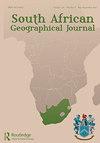Use of multispectral satellite data to assess impacts of land management practices on wetlands in the Limpopo Transfrontier River Basin, South Africa
IF 1.4
4区 社会学
Q3 GEOGRAPHY
引用次数: 12
Abstract
ABSTRACT The study sought to assess the impacts of land use and land cover (LULC) changes on two wetland systems (Makuleke and Nylsvley Nature Reserve) in the Limpopo Transfrontier River Basin (LTRB) in South Africa between 2014 and 2018. To fulfil this objective, multi-date Landsat images were used. Furthermore, the maximum likelihood classification algorithm was used to identify various LULC classes within delineated wetlands. The LULC changes were mapped from the two wetlands, with high overall accuracies, ranging from 80% to 89% for both study areas. The spatial extent of the Makuleke wetland declined by 2% between 2014 and 2018, whereas the Nylsvley wetland decreased by 3%. Built-up areas have increased slightly over the 2014 and 2018 period because of population growth and infrastructure development, which occupy a portion of the wetland. In Nylsvley wetland, it was evident that during the 5-year monitoring period, croplands increased steadily in the Nylsvley catchment. Overall, the results demonstrated a steady decline in natural vegetation cover in both wetlands. This information can aid in enforcing wetland legislations and LULC management practices that can help protect them from further encroachment and degradation.利用多光谱卫星数据评估南非林波波跨境河流域土地管理做法对湿地的影响
摘要:本研究旨在评估2014 - 2018年南非林波波跨境河流域(LTRB)两个湿地系统(Makuleke和Nylsvley自然保护区)土地利用和土地覆盖(LULC)变化的影响。为了实现这一目标,使用了多日期陆地卫星图像。此外,利用最大似然分类算法对所圈定湿地内不同类型的LULC进行了识别。利用这两个湿地绘制了LULC变化图,总体精度在80% ~ 89%之间。2014 - 2018年间,Makuleke湿地的空间面积下降了2%,而Nylsvley湿地的空间面积下降了3%。由于人口增长和基础设施发展,建成区在2014年和2018年期间略有增加,占据了一部分湿地。在Nylsvley湿地,在5年的监测期内,Nylsvley流域的耕地数量明显增加。总体而言,结果表明两个湿地的自然植被覆盖度稳步下降。这些信息可以帮助执行湿地立法和土地利用资源管理实践,从而帮助保护湿地免受进一步的侵蚀和退化。
本文章由计算机程序翻译,如有差异,请以英文原文为准。
求助全文
约1分钟内获得全文
求助全文
来源期刊

South African Geographical Journal
GEOGRAPHY-
CiteScore
3.40
自引率
7.10%
发文量
25
期刊介绍:
The South African Geographical Journal was founded in 1917 and is the flagship journal of the Society of South African Geographers. The journal aims at using southern Africa as a region from, and through, which to communicate geographic knowledge and to engage with issues and themes relevant to the discipline. The journal is a forum for papers of a high academic quality and welcomes papers dealing with philosophical and methodological issues and topics of an international scope that are significant for the region and the African continent, including: Climate change Environmental studies Development Governance and policy Physical and urban Geography Human Geography Sustainability Tourism GIS and remote sensing
 求助内容:
求助内容: 应助结果提醒方式:
应助结果提醒方式:


